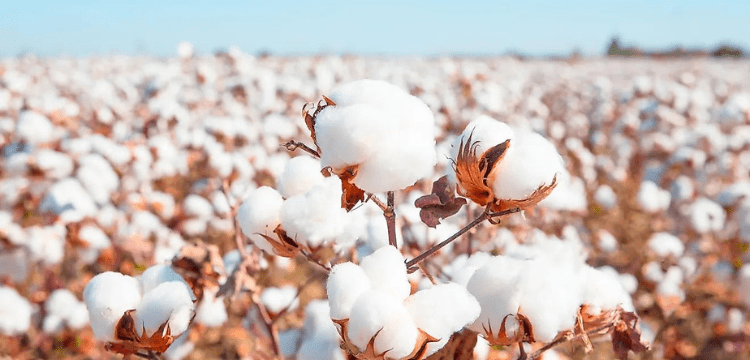[vc_row][vc_column][vc_column_text dp_text_size=”size-4″]ISLAMABAD: Pakistan is facing a sharp decline in cotton production as its per-acre yield has contracted to just half of the cotton productivity in regional countries.
Owing to thin profit margins for cotton planting, farmers have switched over to other crops like rice, maize and sugarcane. Cotton production has consistently declined over the years, causing economic policymakers to express grave concern.
In a recent meeting of the Economic Coordination Committee (ECC), the policymakers and Finance Minister Ishaq Dar observed that the cotton sowing area was shrinking, which was a cause of concern for the government. Dar, who chairs the ECC meetings, pointed out that the per-acre cotton production in regional countries was double the per-acre harvest in Pakistan.
It was emphasised that the Ministry of National Food Security and Research would work with the Ministry of Industries and Production to develop a support price mechanism.
The ECC noted that for the cotton support price, the wheat and sugarcane model might be considered.
Read More: SC gives interim relief against deemed income tax on real estate
The Commerce Division Secretary emphasised the importance of adopting international principles and conducting a study on crop comparative advantages.
The Ministry of National Food Security recalled that cotton production, the mainstay of Pakistan’s agricultural economy, peaked at 14.1 million bales in the 2004-05 season. However, its harvest averaged around 12 million bales in later years, while output dropped to 7 million bales in 2020-21 and 9.45 million bales in 2021-22 in the last four years.
Furthermore, the unprecedented floods in 2022 severely harmed the standing cotton crop, reducing overall production to 4.76 million bales (based on cotton arrivals through March 3, 2023) versus the target of 9 million bales.
The ministry stated that cotton production was decreasing and at the same time planting area was also shrinking. To meet the demand of textile industry, Pakistan has the potential to ramp up cotton production to 15 million bales in a short time span.
It was stated that the cotton price intervention policy during 2021-22 had resulted in price stability in the domestic market and higher investment in crop management, increasing production by 2 million bales despite a 7% decline in the cultivated area.
Similarly, the policy adopted in 2022-23 also ensured price stability in the domestic market. However, the unprecedented floods significantly damaged the standing crop.
The Ministry of National Food Security informed the ECC that in order to draw up a cotton intervention price proposal, consultations were held with all stakeholders including the provincial governments, growers and cotton associations in January and February 2023.
Growers proposed an intervention price of Rs7,000-8,000 per 40 kg.
Since the last consultation on February 10, 2023, the cost of inputs had further increased. The revised average cost of production “is now approximately Rs7,000 per 40 kg”, the food ministry said.
Stakeholders, including the All Pakistan Textile Mills Association, have called for the cotton intervention price to be tied to the import parity price, as has been done for the past two years. The ministry stated that at a meeting held at the Prime Minister’s Office on March 13, 2023, it was decided to submit a summary proposing a cotton intervention price of Rs8,500 per 40 kg for ECC’s consideration.
It was emphasised that the announcement of the intervention price ahead of the main sowing season would assist growers in deciding on planting area and crop management investment. The proposed price was anticipated to boost yield and sowing area by 10-15%. The Ministry of National Food Security submitted the following proposals for consideration and approval by the ECC.
Fix the intervention price for cotton (phutti) at Rs8,500 per 40 kg.
Establish a cotton price review committee with the mandate to review market prices and propose interventions every two weeks.
Cotton lint (base grade-III with a staple length of 1-1/32″) should be purchased from pre-selected ginning factories by provinces or the Trading Corporation of Pakistan (TCP).
ECC should advise TCP or provinces when to sell the procured cotton after assessing the local and international markets. Monitor cotton prices in the main markets of Punjab and Sindh, as well as the international market, on a weekly basis, and issue a brief price report.
When domestic prices of cotton (phutti) drop below the threshold of Rs8,500 per 40 kg, trigger the intervention price at a 10% discount to the estimated import parity price.
The ECC reviewed the summary titled “Cotton Intervention Price for 2023-24 Crop” submitted by the Ministry of National Food Security and decided to set the cotton (phutti) intervention price for the current crop at Rs8,500 per 40 kg.
It also established a cotton price review committee, tasked with reviewing market prices and proposing interventions every two weeks.
The committee will monitor cotton prices in the main markets of Punjab and Sindh as well as the international market on a weekly basis and issue a brief report.
The ECC directed the Ministry of National Food Security to present a report on the price review committee’s deliberations at the end of each month.[/vc_column_text][/vc_column][/vc_row]











